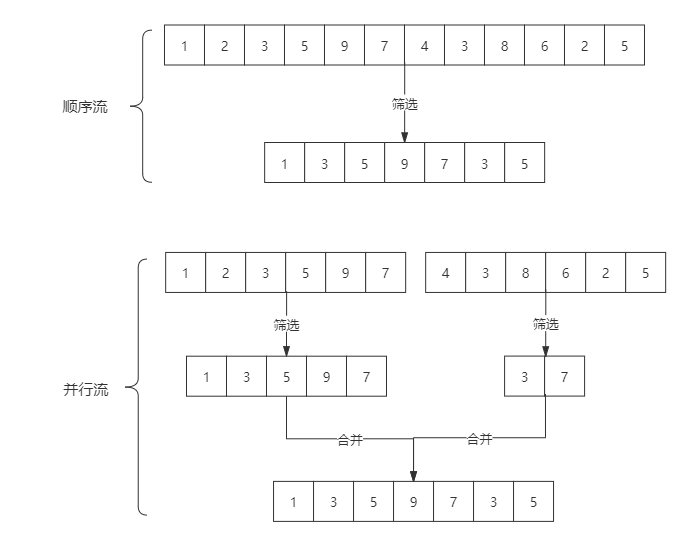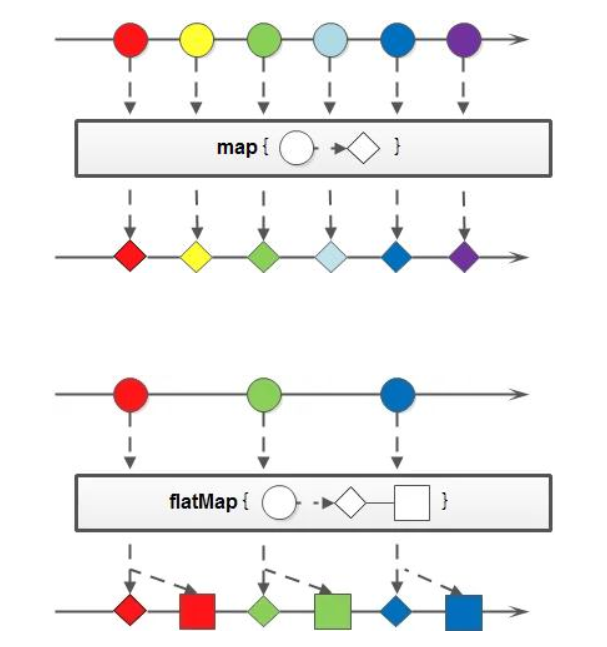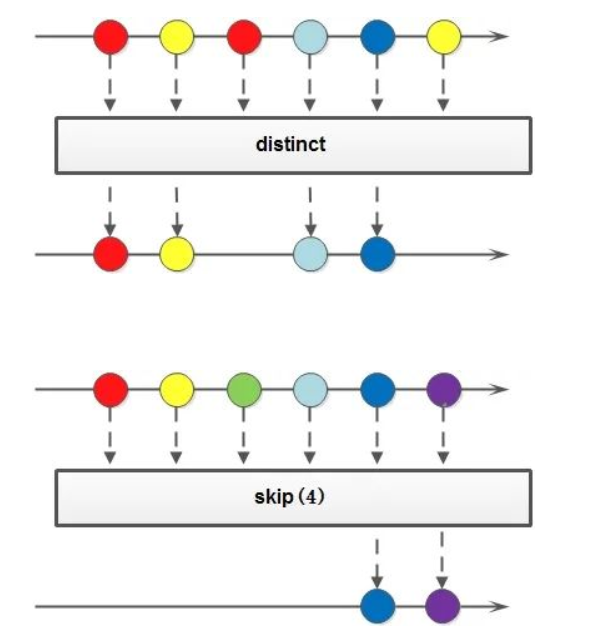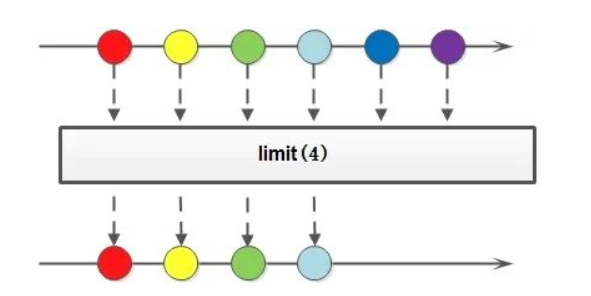1、Stream流结构图

体验实战案例:
1. 从员工集合中筛选出salary大于8000的员工,并放置到新的集合里。
2. 统计员工的最高薪资、平均薪资、薪资之和。
3. 将员工按薪资从高到低排序,同样薪资者年龄小者在前。
4. 将员工按性别分类,将员工按性别和地区分类,将员工按薪资是否高于8000分为两部分。
用传统的迭代处理也不是很难,但代码就显得冗余了,跟Stream相比高下立判。Java 8 是一个非常成功的版本,这个版本新增的Stream,配合同版本出现的 Lambda ,给我们操作集合(Collection)提供了极大的便利。
2、Stream简介
- Stream将要处理的元素集合看作一种流,在流的过程中,借助Stream API对流中的元素进行操作,比如:筛选、排序、聚合等。
- Stream可以由数组或集合创建,对流的操作分为两种:
- 中间操作,每次返回一个新的流,可以有多个。(调用filter、map等api)
- 终端操作,每个流只能进行一次终端操作,终端操作结束后流无法再次使用。终端操作会产生一个新的集合或值。(调用collect)
- Stream的三个特性:
- stream不存储数据,而是按照特定的规则对数据进行计算,一般会输出结果。
- stream不会改变数据源,通常情况下会产生一个新的集合或一个值。
- stream具有延迟执行特性,只有调用终端操作时,中间操作才会执行。
Stream创建的三种方式
通过 java.util.Collection.stream() 方法用集合创建流
List<String> list = Arrays.asList("a", "b", "c");// 创建一个顺序流Stream<String> stream = list.stream();// 创建一个并行流Stream<String> parallelStream = list.parallelStream();
使用java.util.Arrays.stream(T[] array)方法用数组创建流
int[] array={1,3,5,6,8};IntStream stream = Arrays.stream(array);
使用Stream的静态方法:of()、iterate()、generate() ```java Stream
stream = Stream.of(1, 2, 3, 4, 5, 6);
Stream
Stream
- **Stream和parallelStream的区别:**- stream是顺序流,由主线程按顺序对流执行操作,而parallelStream是并行流,内部以多线程并行执行的方式对流进行操作,但前提是流中的数据处理没有顺序要求。例如筛选集合中的奇数,两者的处理不同之处:- 如果流中的数据量足够大,并行流可以加快处速度。除了直接创建并行流,还可以通过parallel()把顺序流转换成并行流:```javaOptional<Integer> findFirst = list.stream().parallel().filter(x->x>6).findFirst();
- Optional概念
Optional类是一个可以为null的容器对象。如果值存在则isPresent()方法会返回true,调用get()方法会返回该对象。
3、20个案例彻底掌握Stream流
案例使用的员工类
这是后面案例中使用的员工类:
/*** @Auther: mojh* @Date: 2022/01/24/10:07* @Description:*/class Person {private String name; // 姓名private int salary; // 薪资private int age; // 年龄private String sex; //性别private String area; // 地区// 构造方法public Person() {}public Person(String name, int salary, int age, String sex, String area) {this.name = name;this.salary = salary;this.age = age;this.sex = sex;this.area = area;}public String getName() {return name;}public void setName(String name) {this.name = name;}public int getSalary() {return salary;}public void setSalary(int salary) {this.salary = salary;}public int getAge() {return age;}public void setAge(int age) {this.age = age;}public String getSex() {return sex;}public void setSex(String sex) {this.sex = sex;}public String getArea() {return area;}public void setArea(String area) {this.area = area;}@Overridepublic String toString() {return "Person{" +"name='" + name + '\'' +", salary=" + salary +", age=" + age +", sex='" + sex + '\'' +", area='" + area + '\'' +'}';}}
import java.util.ArrayList;import java.util.List;import java.util.stream.Collectors;/*** @Auther: mojh* @Date: 2022/01/24/10:15* @Description:*/public class Stream {/* 1. 从员工集合中筛选出salary大于8000的员工,并放置到新的集合里。* 2. 统计员工的最高薪资、平均薪资、薪资之和。* 3. 将员工按薪资从高到低排序,同样薪资者年龄小者在前。* 4. 将员工按性别分类,将员工按性别和地区分类,将员工按薪资是否高于8000分为两部分。*/public static void main(String[] args) {List<Person> personList = new ArrayList<Person>();personList.add(new Person("Tom", 8900, 18, "male", "New York"));personList.add(new Person("Jack", 7000, 23, "male", "Washington"));personList.add(new Person("Lily", 7800, 25, "female", "Washington"));personList.add(new Person("Anni", 8200, 28, "female", "New York"));personList.add(new Person("Owen", 9500, 23, "male", "New York"));personList.add(new Person("Alisa", 7900, 30, "female", "New York"));}}
3.1、遍历/匹配(foreach/find/match)
Stream也是支持类似集合的遍历和匹配元素,只是Stream中的元素是以Optional类型存在的。Stream的遍历、匹配非常简单。
import java.util.ArrayList;import java.util.List;import java.util.Optional;import java.util.stream.Collectors;/*** @Auther: mojh* @Date: 2022/01/24/10:15* @Description:*/public class Stream {/* 1. 从员工集合中筛选出salary大于8000的员工,并放置到新的集合里。List<Person> salaryCollect = personList.stream().filter(employee -> employee.getSalary() > 8000).collect(Collectors.toList());System.out.println(salaryCollect);* 2. 统计员工的最高薪资、平均薪资、薪资之和。* 3. 将员工按薪资从高到低排序,同样薪资者年龄小者在前。* 4. 将员工按性别分类,将员工按性别和地区分类,将员工按薪资是否高于8000分为两部分。*/public static void main(String[] args) {List<Person> personList = new ArrayList<Person>();personList.add(new Person("Tom", 8900, 18, "male", "New York"));personList.add(new Person("Jack", 7000, 23, "male", "Washington"));personList.add(new Person("Lily", 7800, 25, "female", "Washington"));personList.add(new Person("Anni", 8200, 28, "female", "New York"));personList.add(new Person("Owen", 9500, 23, "male", "New York"));personList.add(new Person("Alisa", 7900, 30, "female", "New York"));// 遍历输出符合条件的元素personList.stream().filter(person -> person.getAge() > 20).forEach(System.out::println);// 匹配第一个Optional<Person> person1 = personList.stream().filter(person -> person.getAge() > 20).findFirst();// 匹配任意(适用于并行流)Optional<Person> person2 = personList.parallelStream().filter(person -> person.getAge() > 20).findAny();// 是否包含复合特定条件的元素boolean anyMatch = personList.stream().anyMatch(person -> person.getAge() < 20);System.out.println("匹配第一个值:" + person1.get());System.out.println("匹配任意一个值:" + person2.get());System.out.println("是否存在年龄小于20的用户:" + anyMatch);}}
3.2、筛选(filter)
筛选,是按照一定的规则校验流中的元素,将符合条件的元素提取到新的流中的操作。

案例一:从员工集合中筛选出salary大于8000的员工,并放置到新的集合里。
import java.util.ArrayList;import java.util.List;import java.util.Optional;import java.util.stream.Collectors;/*** @Auther: mojh* @Date: 2022/01/24/10:15* @Description:*/public class Stream {/* 1. 从员工集合中筛选出salary大于8000的员工,并放置到新的集合里。* 2. 统计员工的最高薪资、平均薪资、薪资之和。* 3. 将员工按薪资从高到低排序,同样薪资者年龄小者在前。* 4. 将员工按性别分类,将员工按性别和地区分类,将员工按薪资是否高于8000分为两部分。*/public static void main(String[] args) {List<Person> personList = new ArrayList<Person>();personList.add(new Person("Tom", 8900, 18, "male", "New York"));personList.add(new Person("Jack", 7000, 23, "male", "Washington"));personList.add(new Person("Lily", 7800, 25, "female", "Washington"));personList.add(new Person("Anni", 8200, 28, "female", "New York"));personList.add(new Person("Owen", 9500, 23, "male", "New York"));personList.add(new Person("Alisa", 7900, 30, "female", "New York"));// 从员工集合中筛选出salary大于8000的员工,并放置到新的集合里。List<String> salaryCollect = personList.stream().filter(person -> person.getSalary() > 8000).map(person -> person.getName()).collect(Collectors.toList());System.out.println(salaryCollect);}}
filter的复杂案例
Set<String> offerIds = umOffers.stream().map(umOffer -> MapUtils.getString((IData) umOffer, "OFFER_ID")).distinct().collect(Collectors.toSet());List<String> upfrontOfferIds = Lists.newArrayList(StringUtils.split(para2, TerminalBusiConst.RetailTerminalUpfrontOfferConfig.REGEX));//订购了主套餐及预缴Offer,订购了优惠,不展示List<String> saleOfferIds = offerIds.stream().filter(upfrontOfferIds::contains).collect(Collectors.toList());if (CollectionUtils.isNotEmpty(saleOfferIds)) {upfrontOfferIds.removeIf(saleOfferIds::contains);notDisplayOfferIds.addAll(saleOfferIds);}
- 关于 :: 符号的含义:
当我们并不想要自己去实现接口的方法,只是想传进去一个已经有过实现了的方法,就可以使用::。它的语法规则如下:
类名::静态方法名 或者 类的实例::实例方法。
3.3、聚合(max/min/count)
max、min、count这些字眼你一定不陌生,没错,在mysql中我们常用它们进行数据统计。Java stream中也引入了这些概念和用法,极大地方便了我们对集合、数组的数据统计工作。
案例二:获取员工工资最高的人。
public class Stream {/* 1. 从员工集合中筛选出salary大于8000的员工,并放置到新的集合里。* 2. 统计员工的最高薪资、平均薪资、薪资之和。* 3. 将员工按薪资从高到低排序,同样薪资者年龄小者在前。* 4. 将员工按性别分类,将员工按性别和地区分类,将员工按薪资是否高于8000分为两部分。*/public static void main(String[] args) {List<Person> personList = new ArrayList<Person>();personList.add(new Person("Tom", 8900, 18, "male", "New York"));personList.add(new Person("Jack", 7000, 23, "male", "Washington"));personList.add(new Person("Lily", 7800, 25, "female", "Washington"));personList.add(new Person("Anni", 8200, 28, "female", "New York"));personList.add(new Person("Owen", 9500, 23, "male", "New York"));personList.add(new Person("Alisa", 7900, 30, "female", "New York"));// 获取员工工资最高的人Person personMaxSalary = Person personMaxSalary = personList.stream().max(Comparator.comparingInt(Person::getSalary)).get();System.out.println(personMaxSalary);}}
- 注意点:使用max(),如果需要通过对象中的某个字段进行比较,需要通过Comparator.comparing()获取对应的字段进行比较,方法调用后得到的结果是Optional。在后面通过get()方法获取。
案例三:计算Integer集合中大于6的元素的个数。
import java.util.Arrays;import java.util.List;public class StreamTest {public static void main(String[] args) {List<Integer> list = Arrays.asList(7, 6, 4, 8, 2, 11, 9);long count = list.stream().filter(x -> x > 6).count();System.out.println("list中大于6的元素个数:" + count);}}
-
3.4、映射(map)
映射,可以将一个流的元素按照一定的映射规则映射到另一个流中。分为map和flatMap:
map:接收一个函数作为参数,该函数会被应用到每个元素上,并将期映射成一个新的元素。
- flatMap:接收一个函数作为参数,将流中的每个值都换成另一个流,然后把所有流连接成一个流

案例四:英文字符串数组的元素全部改为大写。整数数组每个元素+3。
public class StreamTest {public static void main(String[] args) {String[] strArr = { "abcd", "bcdd", "defde", "fTr" };List<String> strList = Arrays.stream(strArr).map(String::toUpperCase).collect(Collectors.toList());List<Integer> intList = Arrays.asList(1, 3, 5, 7, 9, 11);List<Integer> intListNew = intList.stream().map(x -> x + 3).collect(Collectors.toList());System.out.println("每个元素大写:" + strList);System.out.println("每个元素+3:" + intListNew);}
3.5、规约(reduce)
归约,也称缩减,顾名思义,是把一个流缩减成一个值,能实现对集合求和、求乘积和求最值操作。
案例五:求Integer集合的元素之和、乘积和最大值。
public class StreamTest {public static void main(String[] args) {List<Integer> list = Arrays.asList(1, 3, 2, 8, 11, 4);// 求和方式1Optional<Integer> sum = list.stream().reduce((x, y) -> x + y);// 求和方式2Optional<Integer> sum2 = list.stream().reduce(Integer::sum);// 求和方式3Integer sum3 = list.stream().reduce(0, Integer::sum);// 求乘积Optional<Integer> product = list.stream().reduce((x, y) -> x * y);// 求最大值方式1Optional<Integer> max = list.stream().reduce((x, y) -> x > y ? x : y);// 求最大值写法2Integer max2 = list.stream().reduce(1, Integer::max);System.out.println("list求和:" + sum.get() + "," + sum2.get() + "," + sum3);System.out.println("list求积:" + product.get());System.out.println("list求和:" + max.get() + "," + max2);}}
3.6、收集(collect)
- 收集就是把一个流收集起来,最终可以是收集成一个值,也可以收集成一个新的集合
collect主要依赖于java.util.stream.Collectors类内置的静态方法
3.6.1、收集(toList/toSet/toMap)
因为流不存储数据,那么在流中的数据完成处理后,需要将流中的数据重新归集到新的集合里。toList、toSet、和toMap比较常用,另外还有toCollection、toConcurrentMap等复杂一些的用法
public class StreamTest {public static void main(String[] args) {List<Integer> list = Arrays.asList(1, 6, 3, 4, 6, 7, 9, 6, 20);List<Integer> listNew = list.stream().filter(x -> x % 2 == 0).collect(Collectors.toList());Set<Integer> set = list.stream().filter(x -> x % 2 == 0).collect(Collectors.toSet());List<Person> personList = new ArrayList<Person>();personList.add(new Person("Tom", 8900, 23, "male", "New York"));personList.add(new Person("Jack", 7000, 25, "male", "Washington"));personList.add(new Person("Lily", 7800, 21, "female", "Washington"));personList.add(new Person("Anni", 8200, 24, "female", "New York"));Map<?, Person> map = personList.stream().filter(p -> p.getSalary() > 8000).collect(Collectors.toMap(Person::getName, p -> p));System.out.println("toList:" + listNew);System.out.println("toSet:" + set);System.out.println("toMap:" + map);}}
3.6.2、统计(count/averaging)
Collectors提供了一系列用于数据统计的静态方法:
- 计数:count
- 平均值:averagingInt、averaginLong、averaginDouble
- 求值:maxBy、minBy
- 求和:summingInt、summingLong、summingDouble
- 统计以上所有:summarizingInt、summarizingLong、summarizingDouble
案例六:统计员工人数、平均工资、工资总额、最高工资。
public class StreamTest {public static void main(String[] args) {List<Person> personList = new ArrayList<Person>();personList.add(new Person("Tom", 8900, 23, "male", "New York"));personList.add(new Person("Jack", 7000, 25, "male", "Washington"));personList.add(new Person("Lily", 7800, 21, "female", "Washington"));// 求总数Long count = personList.stream().collect(Collectors.counting());// 求平均工资Double average = personList.stream().collect(Collectors.averagingDouble(Person::getSalary));// 求最高工资Optional<Integer> max = personList.stream().map(Person::getSalary).collect(Collectors.maxBy(Integer::compare));// 求工资之和Integer sum = personList.stream().collect(Collectors.summingInt(Person::getSalary));// 一次性统计所有信息DoubleSummaryStatistics collect = personList.stream().collect(Collectors.summarizingDouble(Person::getSalary));System.out.println("员工总数:" + count);System.out.println("员工平均工资:" + average);System.out.println("员工工资总和:" + sum);System.out.println("员工工资所有统计:" + collect);}}
3.6.3、分组(partitioningBy/groupingBy)
- 分区:将stream按条件分为两个Map,比如员工按薪资是否高于8000分为两部份。
- 分组:将集合分为多个Map,比如员工按性别分组。有单级分组和多级分组。

案例七:将员工按薪资是否高于8000分为两部分;将员工按性别和地区分组
public class StreamTest {public static void main(String[] args) {List<Person> personList = new ArrayList<Person>();personList.add(new Person("Tom", 8900, "male", "New York"));personList.add(new Person("Jack", 7000, "male", "Washington"));personList.add(new Person("Lily", 7800, "female", "Washington"));personList.add(new Person("Anni", 8200, "female", "New York"));personList.add(new Person("Owen", 9500, "male", "New York"));personList.add(new Person("Alisa", 7900, "female", "New York"));// 将员工按薪资是否高于8000分组Map<Boolean, List<Person>> part = personList.stream().collect(Collectors.partitioningBy(x -> x.getSalary() > 8000));// 将员工按性别分组Map<String, List<Person>> group = personList.stream().collect(Collectors.groupingBy(Person::getSex));// 将员工先按性别分组,再按地区分组Map<String, Map<String, List<Person>>> group2 = personList.stream().collect(Collectors.groupingBy(Person::getSex, Collectors.groupingBy(Person::getArea)));System.out.println("员工按薪资是否大于8000分组情况:" + part);System.out.println("员工按性别分组情况:" + group);System.out.println("员工按性别、地区:" + group2);}}
3.6.4、接合(joining)
joining可以将stream中的元素用特定的连接符(没有的话,则直接连接)连接成一个字符串。
public class StreamTest {public static void main(String[] args) {List<Person> personList = new ArrayList<Person>();personList.add(new Person("Tom", 8900, 23, "male", "New York"));personList.add(new Person("Jack", 7000, 25, "male", "Washington"));personList.add(new Person("Lily", 7800, 21, "female", "Washington"));String names = personList.stream().map(p -> p.getName()).collect(Collectors.joining(","));System.out.println("所有员工的姓名:" + names);List<String> list = Arrays.asList("A", "B", "C");String string = list.stream().collect(Collectors.joining("-"));System.out.println("拼接后的字符串:" + string);}}
3.6.5、归约(reducing)
Collectors类提供的reducing方法,相比于stream本身的reduce方法,增加了对自定义归约的支持。
public class StreamTest {public static void main(String[] args) {List<Person> personList = new ArrayList<Person>();personList.add(new Person("Tom", 8900, 23, "male", "New York"));personList.add(new Person("Jack", 7000, 25, "male", "Washington"));personList.add(new Person("Lily", 7800, 21, "female", "Washington"));// 每个员工减去起征点后的薪资之和(这个例子并不严谨,但一时没想到好的例子)Integer sum = personList.stream().collect(Collectors.reducing(0, Person::getSalary, (i, j) -> (i + j - 5000)));System.out.println("员工扣税薪资总和:" + sum);// stream的reduceOptional<Integer> sum2 = personList.stream().map(Person::getSalary).reduce(Integer::sum);System.out.println("员工薪资总和:" + sum2.get());}}
3.7、排序
sorted,中间操作。有两种排序:
- sorted():自然排序,流中元素需实现Comparable接口
- sorted(Comparator com):Comparator排序器自定义排序
案例八:将员工按工资由高到低(工资一样则按年龄由大到小)排序
public class StreamTest {public static void main(String[] args) {List<Person> personList = new ArrayList<Person>();personList.add(new Person("Sherry", 9000, 24, "female", "New York"));personList.add(new Person("Tom", 8900, 22, "male", "Washington"));personList.add(new Person("Jack", 9000, 25, "male", "Washington"));personList.add(new Person("Lily", 8800, 26, "male", "New York"));personList.add(new Person("Alisa", 9000, 26, "female", "New York"));// 按工资升序排序(自然排序)List<String> newList = personList.stream().sorted(Comparator.comparing(Person::getSalary)).map(Person::getName).collect(Collectors.toList());// 按工资倒序排序List<String> newList2 = personList.stream().sorted(Comparator.comparing(Person::getSalary).reversed()).map(Person::getName).collect(Collectors.toList());// 先按工资再按年龄升序排序List<String> newList3 = personList.stream().sorted(Comparator.comparing(Person::getSalary).thenComparing(Person::getAge)).map(Person::getName).collect(Collectors.toList());// 先按工资再按年龄自定义排序(降序)List<String> newList4 = personList.stream().sorted((p1, p2) -> {if (p1.getSalary() == p2.getSalary()) {return p2.getAge() - p1.getAge();} else {return p2.getSalary() - p1.getSalary();}}).map(Person::getName).collect(Collectors.toList());System.out.println("按工资升序排序:" + newList);System.out.println("按工资降序排序:" + newList2);System.out.println("先按工资再按年龄升序排序:" + newList3);System.out.println("先按工资再按年龄自定义降序排序:" + newList4);}}
3.8、提取\组合


public class StreamTest {public static void main(String[] args) {String[] arr1 = { "a", "b", "c", "d" };String[] arr2 = { "d", "e", "f", "g" };Stream<String> stream1 = Stream.of(arr1);Stream<String> stream2 = Stream.of(arr2);// concat:合并两个流 distinct:去重List<String> newList = Stream.concat(stream1, stream2).distinct().collect(Collectors.toList());// limit:限制从流中获得前n个数据List<Integer> collect = Stream.iterate(1, x -> x + 2).limit(10).collect(Collectors.toList());// skip:跳过前n个数据List<Integer> collect2 = Stream.iterate(1, x -> x + 2).skip(1).limit(5).collect(Collectors.toList());System.out.println("流合并:" + newList);System.out.println("limit:" + collect);System.out.println("skip:" + collect2);}}

